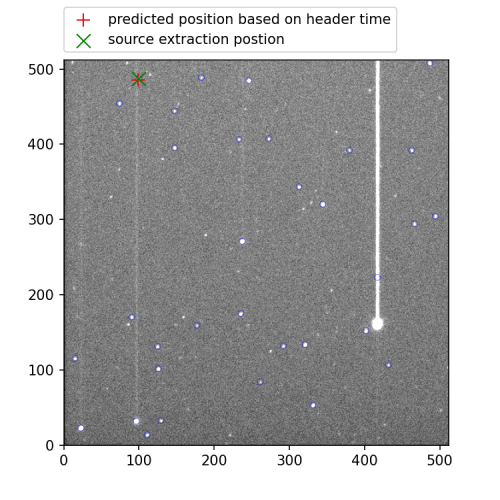Difference between revisions of "74" / 1.9m - Instrument Selector"
(→Instrument Description) |
(→Instrument Description) |
||
| Line 10: | Line 10: | ||
NB. (2) The annulas mirror, which used to be actuated to switch between acquistion and guiding mode, should '''NOT''' be actuated anymore for any reason. There is no danger in doing so but the new routines rely on the annuls mirror staying in the "SCIENCE" position (see screenshot below). There are plans to maybe disable the actuating motor eventually. | NB. (2) The annulas mirror, which used to be actuated to switch between acquistion and guiding mode, should '''NOT''' be actuated anymore for any reason. There is no danger in doing so but the new routines rely on the annuls mirror staying in the "SCIENCE" position (see screenshot below). There are plans to maybe disable the actuating motor eventually. | ||
| + | |||
| + | [[File:mookodi_sat_pred_vs_source_pos.gif|frame|left|Figure1: Shown is an animated gif of 50 frames @ 2×2 binning, fast (5 MHz) readout rate, and 100ms exposure time per frame of an observation of a GNSS satellite moving through the FoV. Note the readout smear, which is particularly apparent for bright stars, due to the shutter set to the "ALWAYS OPEN" mode. '''NB. This mode is MANDATORY for continues fast imaging.''' Approximate time between each frame is ~400ms (i.e., ~300ms dead-time between each frame due to image readout time, header information collection + population into fits header, and file written to disk). The CCD is flushed to clear any charge collected on the chip during dead-time before next frame is taken. The blue circles show the auto-detection of sources and which are used for astrometric calibration. The red cross shows the predicted postion of the satellite at the header time (keyword=DATE-OBS) + half the exposure time (in this case 50us) by querying an independent external satellite database. The green cross shows the position of the auto-detected source extracted that is closest predicted postion]] | ||
Revision as of 11:31, 22 February 2024
Instrument Description
The "Instrument Selector" is essentially a new fold mirror that has been installed in the acquisition boxes of both SpUpNIC and HiPPO[1] that allows the observer to switch between two instruments: a "primary" and a "secondary" instrument where the primary instrument is either SpUpNIC or HiPPo and the secondary instrument is always a new SHOC system. In other words, a SHOC is from now on permanently available on the 74-inch.
Below is the image showing the new SHOC system mounted to the side of SpUpNIC's acquisition box. The new SHOC system replaces the old guider box that use to migrate between SpUpNIC and HiPPo. The new SHOC system is incorporated into a newly designed off-axis "pick-off" style guider system that can accommodate a filter wheel unit and SHOC camera behind the guider.
To select between the primary instrument and SHOC, a user can actuate the fold mirror in/out of the beam to direct the science beam towards the desired instrument (see figure below for button on TCS that actuates the fold mirror). When the fold mirror is IN beam and the guider's XY stages are "centred" then the guider camera also functions as a "target acquisition" camera for SpUpNIC/HiPPo, similar to the old system. Also as in the old system, the guider can patrol the area of the large annulas mirror to acquire an appropriate guide star.
NB. (1) Because the fold mirror and annulas guide mirror are displaced relative to one another in the optical z-axis the guide/acquisition camera's focus has to be adjusted substantially when switching between guiding and target-acquiring mode. This cheat-sheet provides guidelines for focus settings and summarises instructions how to set up target-acquisition and guiding for the primary and secondary instrument: cheat-sheet.
NB. (2) The annulas mirror, which used to be actuated to switch between acquistion and guiding mode, should NOT be actuated anymore for any reason. There is no danger in doing so but the new routines rely on the annuls mirror staying in the "SCIENCE" position (see screenshot below). There are plans to maybe disable the actuating motor eventually.

- Jump up ↑ 22 Feb 2024: the implementation of the fold mirror in HiPPo's acquisition box has not been completed at time of writing